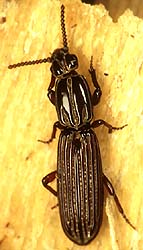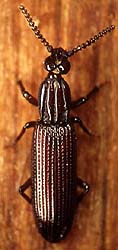Wrinkle beetle
| Wrinkle beetle | ||||||||||||
|---|---|---|---|---|---|---|---|---|---|---|---|---|

|
||||||||||||
| Systematics | ||||||||||||
|
||||||||||||
| Scientific name | ||||||||||||
| Rhysodidae | ||||||||||||
| Laporte , 1840 |
The wrinkle beetles (Rhysodidae) are a family of the beetle suborder Adephaga . The group is still controversial regarding their kinship position, although their monophyly is considered to be sufficiently justified. Many authors put the group as a subfamily to the ground beetles (Carabidae) and another approach sees them as a tribe Rhysodini as incertae sedis within the ground beetle. The family is found worldwide, but the beetles are generally very rare. Both the larvae and the adult beetles live in dead wood, where they feed on slime molds and fungi. Contrary to earlier thought, the adults do not gnaw corridors, but push their heavily armored bodies through the substrate, which they push aside.
features
Beetle
The beetles are 4.5 to 9.5 millimeters long. They are dark red to almost black in color, although the color apparently darkens with increasing age. The compound eyes are clearer and more recognizable functional in the lighter and apparently younger animals, but are darkened by pigments in dark animals. Its heavily sclerotized body is cylindrical and has parallel side edges. The head, the neck plate and partly to the wing covers (elytra) are mines. The beetles' sensory hairs are partially or severely reduced. The head has a strongly articulated (condyliform) neck area. In the winged species, the compound eyes are shallow, rounder and less long than deep. In the species with receding wings, they are oval, crescent-shaped, resemble a pinhole or are separated into two pinhole -shaped structures. A pit is usually formed on the dorsal side of the head, but this is missing in the medisorina . The head also has a median lobe and lobes of different sizes and shapes towards the temples (temporal). In addition, some species have a para-frontal hump. The lobes are separated by the postclypeal, antennal, and frontal pits. The small labrum is triangular or rounded and carries one or two pairs of sets. The antennae are like a string of pearls (moniliform), with each individual link connected to the previous one by a hinge-shaped part. The feelers carry a complex arrangement of sets. The mandibles are only partially visible. From above the tip and the lateral side can be seen, in the side view only the sides. The ventral mouthparts are inverted. The maxillary palps are covered with the exception of the tip and the distal palpomer. The plate-shaped mentum is very large and forms a large part of the ventral side of the head capsule. It is completely fused with the submentum ventrally and partially or completely fused with it on the sides. Well-developed glands are formed in the area of the labium .
The prothorax is very elongated. The pronotum is narrow and has no turned back margins. It has one or more rarely two sets at the back corner. The prosternal process is broad. The indentations for the hips ( coxes ) of the front legs are very wide at the back. The rails ( tibia ) of the forelegs have a medial hair comb that serves as a cleaning tool. Its location varies depending on the species, from opposite the base of the tarsi to completely distal to this base. Before and after the base of the tarsi lies a pair of medially curved apical processes. The mesothorax is quite long and slightly narrower in front. It has a smooth collar towards the prothorax. The deck wings (elytres) are narrow and have eight or fewer grooves. In more than half of the species the wings are well developed, the remaining species have receded wings. However, the veins have receded and the direct and indirect flight muscles are developed in the winged species, but weaker than those of the other species of the Adephaga .
The abdomen either has parallel edges or is slightly curved laterally. There are six visible sternites . The second has a broad median sclerite between the hips. The seam between the third and fourth sternite can hardly be seen.
larva
The larvae are pale and no longer than 9 millimeters. Your body is maggot-shaped and largely unsclerotized. Urogomphi is also missing . The short head is wedge-shaped when viewed from the side and greatly broadened at the back. Point eyes are missing. The short antennae have four links. They are turned into a membranous elevation. On the apical part of the third phalanx is the flat sensory area ventrolaterally. The mandibles are short and strong. The maxilla has grown into a functional unit with the labium. The Galea and Lacinia are heavily modified. The maxillary palps are four-limbed, the labial palps consist of only one limb. The thorax is short and is only about 30% the length of the abdomen. The legs are six-limbed and just as short. They have a single claw. The prothorax is significantly longer than the meso- and metathorax, and the pronotum and prosternum are more sclerotized than the rest of the body segments. The tergites of the metathorax and the first six abdominal segments have slightly sclerotized areas arranged in pairs and transverse, medially interrupted rows with short spines. In the genus Omoglymmius , the abdominal segments carry pairs of distinct ventrolateral tubercles. In the genus Clinidium these are indistinct. When viewed from above, the ninth segment is the last segment, the tenth, short, conical segment is directed downwards.
Occurrence
The family is widespread worldwide, but has its main distribution focus in the tropics and there in particular in island saunas. Most species are found in New Guinea, Indonesia, the Philippines, and northern South America. Most genera occur in Southeast Asia and Indonesia. About 350 species are known, of which three are found in Europe and only two in Central Europe. In general, the animals rarely appear.
Way of life
The beetles colonize forests with sufficient rainfall, which enables wood to rot on the one hand and the growth of slime molds of the Myxogastria subclass on the other . Both the larvae and the imagines are found on tree trunks, -stümpfen or roots or bark of dead wood. They are less common in roots, but up to a depth of three meters. As far as is known, they feed on these slime molds, but also on mushrooms . The animals are often gregarious, with the exception of the species native to Australia, where this behavior is not as common. Different species can also be found together on the same piece of wood. Fully winged beetles can rarely be caught using light traps or flight traps. This is probably due to the fact that the animals only use the flight to reach deadwood high up on trees and not to spread. Species with receding wings can be found in soil traps in the litter. Adults can live in harder wood than larvae. However, they do not gnaw corridors into the wood, but only push their way through the substrate with their heavily armored bodies. As a result, they compress the cells of the dead wood, so that they expand again behind the animals and close the passage. The larvae are found in short tunnels in the dead wood. They close the tunnels behind them with pieces of wood. Larvae are only found irregularly. They are often found together with adult animals. They are very little explored.
Taxonomy and systematics
The wrinkle beetles are a controversial taxon within the Adephaga. Originally they were placed in the subordination Polyphaga and thus in the vicinity of families with a similar way of life. According to today's view, the group is either an independent family within the Adephaga, or as a tribe of ground beetles. Bag (1993) sees the family Rhysodidae as a sister group of ground beetles. The group's monophyly is supported by a number of autapomorphies , including the way of life in wood, the elongated, cylindrical body of the imagines and the maggot-shaped, unsclerotized body of the larvae. The relationships between the genera within the group are still unclear.
Species (Europe)
- Clinidium (Arctoclinidium) canaliculatum ( OG Costa , 1839)
- Omoglymmius (Omoglymmius) germari ( Ganglbauer , 1891)
- Unequal furrow beetle ( Rhysodes sulcatus Fabricius , 1787)
supporting documents
Individual evidence
- ^ Rolf G. Beutel, Richard AB Leschen: Handbuch der Zoologie - Coleoptera, Beetles, Volume 1: Morphology and Systematics (Archostemata, Adephaga, Myxophaga, Polyphaga partim) . 1st edition. de Gruyter , 2005, ISBN 3-11-017130-9 , p. 138 ff . (English).
- ↑ a b c d e f g h i j k l m n Rolf G. Beutel, Richard AB Leschen: Handbuch der Zoologie - Coleoptera, Beetles, Volume 1: Morphology and Systematics (Archostemata, Adephaga, Myxophaga, Polyphaga partim) . 1st edition. de Gruyter , 2005, ISBN 3-11-017130-9 , p. 146 ff . (English).
- ↑ a b c d e f g h i Rhysodini. Tree of Life webproject, accessed May 7, 2012 .
- ↑ Rhysodinae. Fauna Europaea, Version 2.2, June 3, 2010 , accessed on May 7, 2012 .
- ^ RG Pouch: Phylogenetic analysis of Adephaga (Coleoptera) based on character of the larval head. Systematic Entomology, 18, pp. 127-147, 1993
literature
- Rolf G. Beutel, Richard AB Leschen: Handbuch der Zoologie - Coleoptera, Beetles, Volume 1: Morphology and Systematics (Archostemata, Adephaga, Myxophaga, Polyphaga partim) . 1st edition. de Gruyter , 2005, ISBN 3-11-017130-9 (English).
